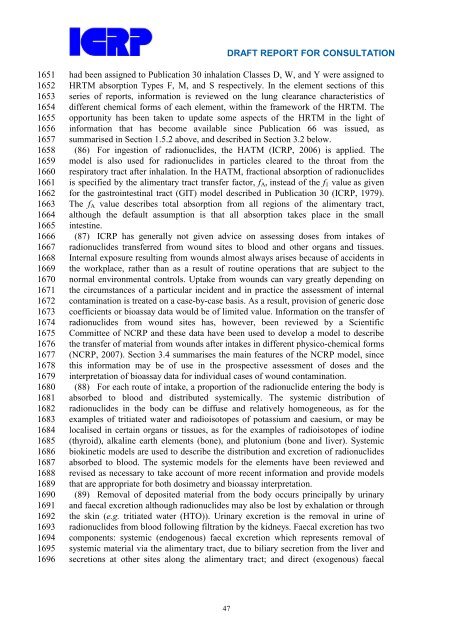Occupational Intakes of Radionuclides Part 1 - ICRP
Occupational Intakes of Radionuclides Part 1 - ICRP
Occupational Intakes of Radionuclides Part 1 - ICRP
Create successful ePaper yourself
Turn your PDF publications into a flip-book with our unique Google optimized e-Paper software.
1651<br />
1652<br />
1653<br />
1654<br />
1655<br />
1656<br />
1657<br />
1658<br />
1659<br />
1660<br />
1661<br />
1662<br />
1663<br />
1664<br />
1665<br />
1666<br />
1667<br />
1668<br />
1669<br />
1670<br />
1671<br />
1672<br />
1673<br />
1674<br />
1675<br />
1676<br />
1677<br />
1678<br />
1679<br />
1680<br />
1681<br />
1682<br />
1683<br />
1684<br />
1685<br />
1686<br />
1687<br />
1688<br />
1689<br />
1690<br />
1691<br />
1692<br />
1693<br />
1694<br />
1695<br />
1696<br />
DRAFT REPORT FOR CONSULTATION<br />
had been assigned to Publication 30 inhalation Classes D, W, and Y were assigned to<br />
HRTM absorption Types F, M, and S respectively. In the element sections <strong>of</strong> this<br />
series <strong>of</strong> reports, information is reviewed on the lung clearance characteristics <strong>of</strong><br />
different chemical forms <strong>of</strong> each element, within the framework <strong>of</strong> the HRTM. The<br />
opportunity has been taken to update some aspects <strong>of</strong> the HRTM in the light <strong>of</strong><br />
information that has become available since Publication 66 was issued, as<br />
summarised in Section 1.5.2 above, and described in Section 3.2 below.<br />
(86) For ingestion <strong>of</strong> radionuclides, the HATM (<strong>ICRP</strong>, 2006) is applied. The<br />
model is also used for radionuclides in particles cleared to the throat from the<br />
respiratory tract after inhalation. In the HATM, fractional absorption <strong>of</strong> radionuclides<br />
is specified by the alimentary tract transfer factor, fA, instead <strong>of</strong> the f1 value as given<br />
for the gastrointestinal tract (GIT) model described in Publication 30 (<strong>ICRP</strong>, 1979).<br />
The fA value describes total absorption from all regions <strong>of</strong> the alimentary tract,<br />
although the default assumption is that all absorption takes place in the small<br />
intestine.<br />
(87) <strong>ICRP</strong> has generally not given advice on assessing doses from intakes <strong>of</strong><br />
radionuclides transferred from wound sites to blood and other organs and tissues.<br />
Internal exposure resulting from wounds almost always arises because <strong>of</strong> accidents in<br />
the workplace, rather than as a result <strong>of</strong> routine operations that are subject to the<br />
normal environmental controls. Uptake from wounds can vary greatly depending on<br />
the circumstances <strong>of</strong> a particular incident and in practice the assessment <strong>of</strong> internal<br />
contamination is treated on a case-by-case basis. As a result, provision <strong>of</strong> generic dose<br />
coefficients or bioassay data would be <strong>of</strong> limited value. Information on the transfer <strong>of</strong><br />
radionuclides from wound sites has, however, been reviewed by a Scientific<br />
Committee <strong>of</strong> NCRP and these data have been used to develop a model to describe<br />
the transfer <strong>of</strong> material from wounds after intakes in different physico-chemical forms<br />
(NCRP, 2007). Section 3.4 summarises the main features <strong>of</strong> the NCRP model, since<br />
this information may be <strong>of</strong> use in the prospective assessment <strong>of</strong> doses and the<br />
interpretation <strong>of</strong> bioassay data for individual cases <strong>of</strong> wound contamination.<br />
(88) For each route <strong>of</strong> intake, a proportion <strong>of</strong> the radionuclide entering the body is<br />
absorbed to blood and distributed systemically. The systemic distribution <strong>of</strong><br />
radionuclides in the body can be diffuse and relatively homogeneous, as for the<br />
examples <strong>of</strong> tritiated water and radioisotopes <strong>of</strong> potassium and caesium, or may be<br />
localised in certain organs or tissues, as for the examples <strong>of</strong> radioisotopes <strong>of</strong> iodine<br />
(thyroid), alkaline earth elements (bone), and plutonium (bone and liver). Systemic<br />
biokinetic models are used to describe the distribution and excretion <strong>of</strong> radionuclides<br />
absorbed to blood. The systemic models for the elements have been reviewed and<br />
revised as necessary to take account <strong>of</strong> more recent information and provide models<br />
that are appropriate for both dosimetry and bioassay interpretation.<br />
(89) Removal <strong>of</strong> deposited material from the body occurs principally by urinary<br />
and faecal excretion although radionuclides may also be lost by exhalation or through<br />
the skin (e.g. tritiated water (HTO)). Urinary excretion is the removal in urine <strong>of</strong><br />
radionuclides from blood following filtration by the kidneys. Faecal excretion has two<br />
components: systemic (endogenous) faecal excretion which represents removal <strong>of</strong><br />
systemic material via the alimentary tract, due to biliary secretion from the liver and<br />
secretions at other sites along the alimentary tract; and direct (exogenous) faecal<br />
47

















